Table of Contents
Blue Dolphin Cichlid Care
The blue dolphin cichlid is a larger fish that needs a big tank with at least 55 gallons to live. It is relatively easy to care for and needs a water temperature of 72-84°F to thrive. These fish also need a lot of wave action and constant filtering in the tank.
Blue Dolphin Cichlid Overview
The blue dolphin cichlid (Cyrtocara moorii), also named Blue Moorii and initially named Haplochromis moorii, is a rare cichlid species. It is plump and long and matures to a good size.
It also has a pointed snout resembling a dolphin, which is how its name came to be blue dolphin cichlid. Malawi blue dolphin is another name for it. They are a haplochromine cichlid species found only in Lake Malawi in East Africa, wherein they favor sandy soils. It can reach a maximum size of 20 cm.
Blue Dolphin Cichlid Quick Stats
| Information Chart | Blue Dolphin Cichlid |
| Scientific Name: | Cyrtocara Moorii |
| Family: | Cichlidae |
| Care Level: | Medium |
| Temperament: | Semi-aggressive |
| Color: | Blue |
| Lifespan: | 10 years |
| Size: | 20-25 cms |
| Diet: | Omnivorous |
| Minimum Tank Size: | 250 liters or more |
| Temperature: | 72-78 degrees Fahrenheit |
| Water Conditions: | Alkaline |
| Tank Mate Compatibility | Moderately Compatible |
Blue Dolphin Cichlid Appearance
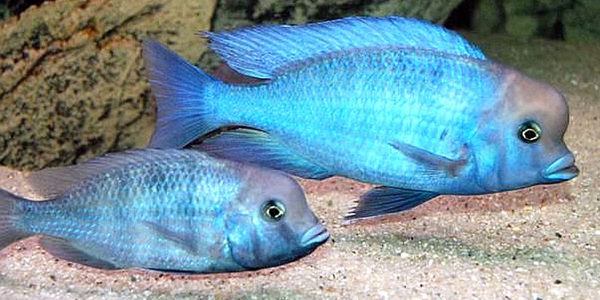
The Blue Moorii is a large cichlid with a stocky, lengthy body and a somewhat hooked nose. Since the pointed snout resembles a dolphin, the Malawi Blue Dolphin and Blue Dolphin Cichlid are named after it. They may develop up to 10 inches (25 cm) in length and go a little bigger in the tank.
Blue dolphin cichlids are a deep blue color with varying black markings on their backs and fins based on their origination. Male cichlids have a more bright colors than females. This is because both males and females grow a bulge (also known as a nuchal bump or hump) on their heads as they age. When the fish fight, their fin and necks turn virtually black, and their bodies turn a vivid blue color. They are warm-blooded animals.
Lifespan Of Blue Dolphin Cichlid
The typical lifespan of a Blue Dolphin Cichlid is up to 10 years.
Blue Dolphin Cichlid Size
The typical Blue Dolphin Cichlid grows up to 20 inches on the lower end and 25 inches for larger specimens. Males reach a height of 20cm, while females reach a height of 16cm. They may develop up to 10 inches (25 cm) in length and go a little larger in the tank.
Natural Habitat and Origin
The Cyrtocara moorii, often known as the Hap moorii or Malawi Cichlids, is a prominent Haplochromis known species in the waters of Lake Malawi in Africa. The blue moorii is a renowned cichlid because of its brilliant blue color and distinctive body frame, including a large hump on the fish’s forehead. They occur naturally in sandy coastal areas for habitation.
Blue Dolphin Cichlid Care & Tank Set-Up
Blue Dolphin Cichlid Tank Size and Specifications
The capacity of the fish tanks is the most crucial consideration when tending aquarium fishes. It must have a total of at least 200-250 liters, or the fish will be uneasy. Furthermore, fish in large tanks can reach a maximum size of 15-20 cm; however, if the aquarium is smaller, the fish will be smaller. The male’s major characteristic, his large head, will not mature adequately in a small tank. The shelters are required, but there should be ample room for swimming. Fish like to live in the middle and lower water layers.
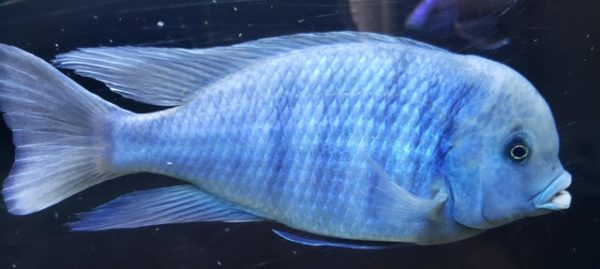
In terms of community tank design, a sandy floor is preferable because fish like to burrow. In addition, they don’t require vegetation since they eat them or tear them up.
In a tank, it’s preferable to have a lot of big flat stones, hooks, and other forms of coverings. Also, because the fish is cautious, it’s best to maintain them in a separate tank. The fish is generally peaceful cichlid, though males can get into battles over supremacy now and then.
In a tank, it’s preferable to have more females than males: one male and two females, or two females and three males, for instance.
Optimum Tank Size for Blue Dolphin Cichlid
The recommended species tank size for Blue Dolphin Cichlids is 250 liters or more. Blue Dolphins require a massive tank of at least 125 gallons based on size.
Tank Shape for Blue Dolphin Cichlid – Huge Spacious Tank
Filter Type-External Canister Filter. These filters are more significant than other types of filtering. This is because they can contain a more substantial number and variety of filter material, leading to a better reduction of waste and bioactivity.
Substrate
Sandy substrate with rocks and barriers to digging into.
How many Blue Dolphin Cichlid in a 55-gallon tank?
You can hold up to 15 African Cichlids in a 55-gallon tank.
Water Parameters for Blue Dolphin Cichlid
Like most African Cichlid tanks, the community tank requires rock caves that can provide hideaways and areas for the fish to establish its domain. Driftwood and hardy plants can be used as well.
Since the Blue Dolphin is a base and middle swimmer, an open swimming area must be given in a good-sized aquarium. In addition, coral with a little care they sand and a tiny rockery should be used to embellish the community aquarium’s open spaces.
A good tank filtering infrastructure is crucial, as well as regular water adjustments of 15%.
Water Temperature
The ideal water temperature for Blue Dolphin Cichlid should be between 72- and 84-degrees Fahrenheit.
pH Level
The perfect water pH level for Blue Dolphin Cichlid is within the range of 7.0 and 8.8. The Cichlid prefers water conditions to be alkaline.
Water Hardness
The hardness of the water can range from 10 to 18 DH.
Blue Dolphin Cichlid Tank Landscape
The mineral richness of the streams that run into Lake Malawi is substantial. This, combined with evaporation, has evolved in extremely mineralized alkaline water. In terms of pH and other liquid mixtures, Lake Malawi is noted for its stability and understanding. So, it’s simple to see why all Lake Malawi fish require constant monitoring of tank settings.
Cichlids from the Rift Valley require hard, alkaline, and are not seen in brackish water. To improve the carbonate hardness of water, salt is occasionally employed as a stabilizing agent. Since this Cichlid can tolerate some salt, it can be called a saltwater fish in mild Saline water. It is not, unfortunately, suitable for a full brackish water tank. It can withstand saline of roughly 10%.
A lower limit of 75 gallons and a length of 5 feet is the recommended tank requirements. Blue dolphins can live in either freshwater or saline water, but they require a lot of wave action and highly effective filtering. In addition, their eyes will be ruined by poor quality water. They will seem most at ease on a sandy substrate. Sand from either saltwater or freshwater fish can be used.
However, saltwater sand will assist in maintaining a higher ph. Shredded coral or aragonite sand can also raise the carbonate hardness of water and degrades more easily than salts. Keeping the pH above average is crucial, but a higher pH means that ammonia is more harmful. Therefore, these fish require frequent water adjustments.
Best Plants for Blue Dolphin Cichlid Tanks
Small shrubs, mosses. This species can be found in Lake Malawi’s low, sandy areas. They generally avoid the lake’s steep cliffs, which are home to cichlids. If stones and tunnels are used in the aquarium, they should be reduced to a minimum and placed out of the way so that this species has enough room to swim. They are diggers who prefer sandy or coarse gravel as a habitat.
Worst Plants for Blue Dolphin Cichlid Tanks
Large seaweeds and longleaf plants.
Decorations for Blue Dolphin Cichlid Tanks
Adequate
Feeding Blue Dolphin Cichlid
Best Diet for Blue Dolphin Cichlid
In terms of eating, H. Moorii is similar to planktonic eaters. However, it does not have a specific feed specialization.
The blue dolphin eats organic debris, various types of a floating life, delicate ultimate phreatophytes, and benthic boneless worms.
Synthetic, natural, live, and frozen foods, and plant-based feeds are all consumed in the aquarium. However, the meal should be some sort of high protein diet, such as blood worms, shellfish, or worms.
How Often Should You Feed Blue Dolphin Cichlid?
Blue Dolphin Cichlids should typically be fed every 12 hours/ day.
Blue Dolphin Cichlid Behavior and Temperament
This semi-aggressive carnivore can become rather possessive if housed in a confined tank with only a few concealing areas. Since the Blue Dolphin will hide through sand if it senses danger, it’s best to use sand as a habitat.
The good news is that, though it may destroy plants when burrowing itself, it will not consume them because plants are never a regular component of its meaty foods. That’s why you must only put plants in the tank that have solid roots.
Are Blue Dolphin Cichlid Lone or Societal in Nature?
As it is a predator, it only stays fine with fishes larger than it or the same size, and not with small fish. Smaller fish eventually gets preyed on.
Blue Dolphin Cichlid Tank Mates
Ideal Blue Dolphin Cichlid Tank Mates
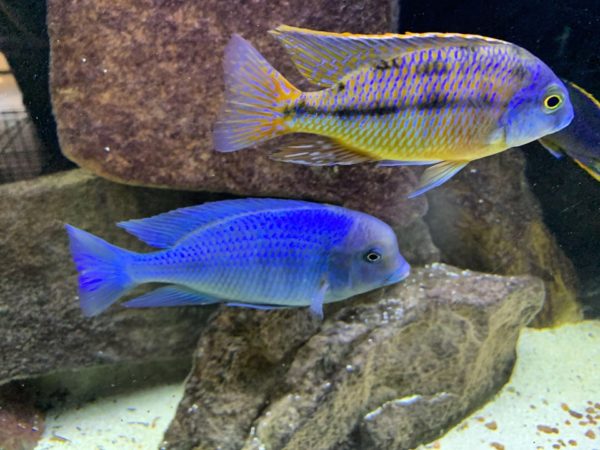
More giant-sized fishes are ideal tank mates for Blue Dolphin Cichlid like:
- Clown Loaches
- Plecos
- Leopard Bush Fish
- Giant Danios
African, red-eyed tetra is also good tank mates for Blue Dolphin Cichlid.
Bad Tank Mates for Blue Dolphin Cichlid
Small, non-aggressive fishes like Guppy fish, Angelfish, Corydoras, Discus, Glassfish should be avoided.
Breeding Blue Dolphin Cichlid
They are polygamous, meaning they form a nest with a male and multiple females. For every male, there may be 3-6 females.
Since determining a fish’s sexuality is challenging, building a swarm of ten juveniles and raising them collectively is ideal.
When the juveniles attain a body length of 12-15 cm, they turn fertile, and they should be split.
Hardness 5 -20°, pH 7.5-9.0, and temperature 25 – 28 °C are the water conditions for reproduction. Finally, the couple participates in the spawning process.
When defending its territory, the male becomes violent, while the females tend to get frightened (and can swallow the eggs if afraid), so it should be safeguarded from anxiety. At times, they cannot be regarded as peaceful fish.
The female mates on a slab of rock, in a pit excavated by the male beforehand, or simply on the ground. The female lays 1-3 eggs, then puts them into her mouth and fertilizes them with the male anal fin.
The couple’s fertility ranges from 20 to 90 eggs.
For 21 days, the female holds eggs in her mouth. Since the female doesn’t consume anything during this time and can get feeble, some fish keepers try to raise the eggs in an environment. They do this by releasing the eggs from the mouth of a spawned-out female.
They placed the eggs in a container with safe water, excellent lighting, and a channel for water. The water in the small tank should have the exact specifications as the giant tanks.
On the seventh day, the youngsters begin to venture outside and feed, but they return to the female’s mouth at the first hint of distress or night. Brine shrimp eggs are a good starter feed.
Blue Dolphin Cichlid Breeding Level
- Hard
Blue Dolphin Cichlid Sexual Dimorphism?
To distinguish between male and female Blue Dolphin Cichlid Males and females of Blue Dolphin cichlids are nearly similar, making them sexually monomorphic. Aside from the possibility that males will develop more significant protrusions or grow slightly more prominent, venting is the most outstanding technique to tell them differently.
Blue Dolphin Cichlid Common Diseases and their Treatment
Hump heads, like any other fish, are prone to stress and disease, especially in low-quality water. Lack of sufficient filtering and abrupt temperature changes or poor water quality will add to their stress levels, weakening their immune function. A proper setup is needed for the cichlids to grow.
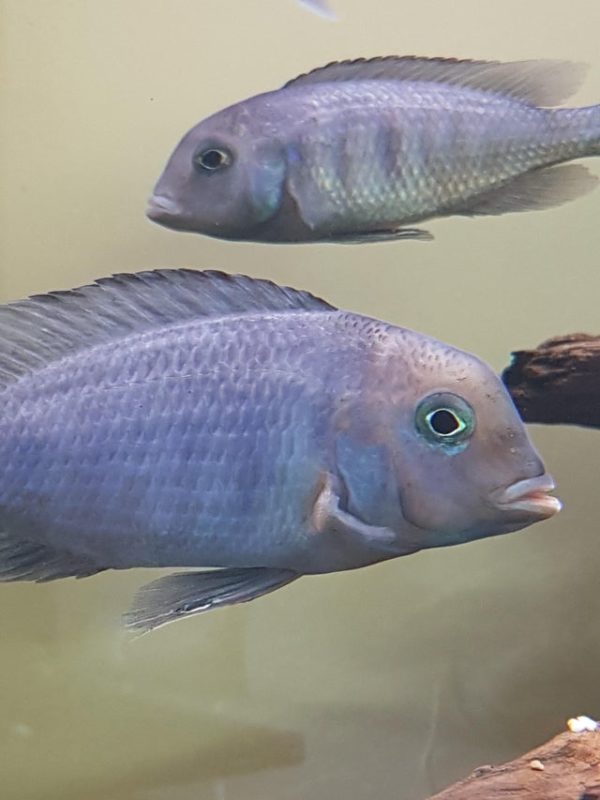
Ich
Ich is the most common ailment in fish, and it is frequently the first to show up whenever the fish are at their most defenseless. However, if caught early enough, it can be cured by raising the temperature of the water to 86 degrees Fahrenheit for three days (one point every hour).
To allow the fish to adjust and lessen stress, this elevation must be done in stages. If this doesn’t work and Ich is still there after three days, you can use copper to treat it, but ensure any liquid conditioner is removed first.
Skin flukes, parasitic, fungal, and bacterial infections are other prevalent illnesses that afflict Blue Dolphins.
To ensure that any additional fish, vegetation, or ornaments you plan to add to your tank are pathogen-free, isolate them first.
Facts about Blue Dolphin Cichlid
- Tastes vary among predatory animals, as do variances in jaw form. Some mollusk eaters crush and devour their prey’s shells intact, while others seize the prey’s outstretched foot and suck it out of the shells. Invertebrate feeders may look for food by picking among algal beds or digging through the murky bottom.
- Creatures that eat plankton filter their food in the open sea. Even though there are numerous feeding habits among cichlid species, others only consume eggs, larvae, or adults, or specific body portions of other fish, such as scale, flippers, or even eyes!
- Every year, new cichlid species are discovered. Unfortunately, protected areas are tough to develop because scientists don’t know however many different types there are.
- Cichlids are susceptible to environmental changes, such as contamination and the introduction of exotic species, which can enhance feeding, rivalry, and hybrids, as can other creatures with highly specialized traits or behavior. Overexploitation and acquisition for the pet trade are major threats to cichlids.
- Some cichlids reproduce in the substrate. The female deposits a line of eggs that the male fertilizes in this method of fertilization. The male and female subsequently guard the eggs till they sprout.
Are Blue Dolphin Cichlids Right for You?
Blue Dolphins are gorgeous fish to maintain if you can buy the room and make a charming existing home or business, even though they demand a bit more care.
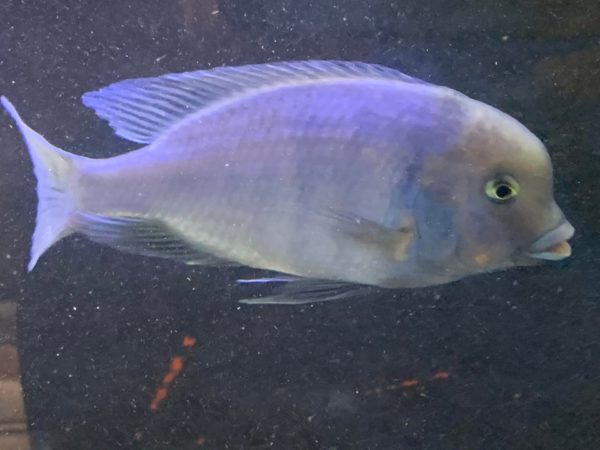
Frequently Asked Questions
How Quickly Do Blue Dolphin Cichlids Mature?
The length of time it takes for Malawi to reach total growth is determined by the factors listed above (species, water quality, diet, genetics, tank volume, etc.). However, from the time they are freshly spat 1cm fry, they can reach ‘adult size’ around 2.5 to 3 years.
When Do Blue Dolphin Cichlids Start Breeding?
Blue dolphins sexually mature around the age of three and begin breeding routinely after that. They usually marry since no other species is present, although if the aquarium is big enough or has sufficient hiding places, they could do so in a communal tank.
Is It True That Blue Dolphin Cichlids Are Violent?
The blue dolphin cichlids are among the more challenging cichlids to spawn, and during the breeding season, they could become rather violent with aquarium mates. During such times, they cannot be called non-aggressive fish.
Conclusion
Although not the easiest fishes to manage and nurture, Blue Dolphin Cichlid is a beautiful addition to your aquarium. With a little care, they will be just perfect for keeping fish, if you refer to an authentic Blue dolphin cichlid care guide!
